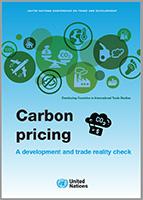
The scientific evidence draws a clear picture: To limit global warming to 1.5 °C above pre-industrial levels, Green House Gas (GHG) emissions need to peak before 2025 and be reduced by 43 per cent by 2030, while net zero emissions need to be achieved globally in the early 2050s (Intergovernmental Panel on Climate Change (IPCC)).
The international climate change legal framework is also clear. It requires all countries to adopt climate change mitigation measures in order to achieve the common objective of limiting the increase in global temperatures to “well below” 2°C but leaves each country free to choose the specific measures and policies to meet their individual emissions reduction targets.
This report focuses on carbon pricing as one policy strand used to tackle global GHG emissions.
It gives an overview of implemented and forthcoming domestic and cross-border carbon pricing mechanisms, as well as their implications for GHG emissions, international trade and development.
It lays out the characteristics of various approaches, including the potential pitfalls and unintended economic and environmental side effects which need to be addressed for these approaches to work.


